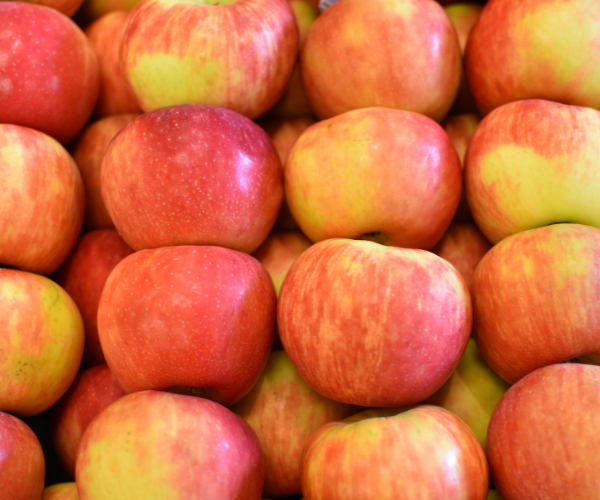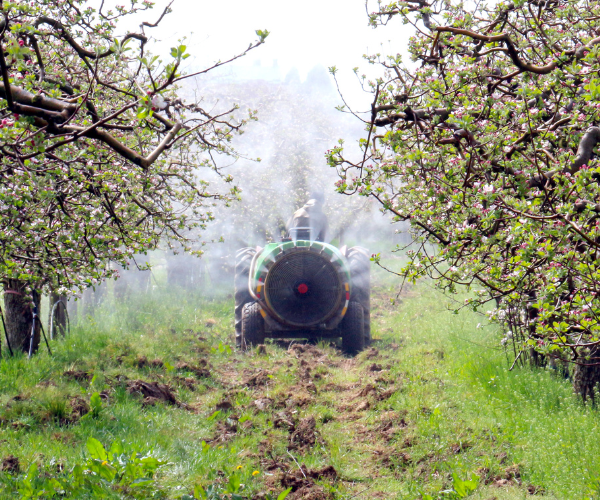
Increasing Yield of Cosmic Crisp® Apples
Applications of the ethylene inhibitor ReTain® Plant Growth Regulator during bloom on other apple varieties has shown the ability to increase fruit set by prolonging the life of the floral organs, thus extending the effective pollination period.
For varieties like WA 38 and Minnieska (SweeTango®), the low yields are less a function of floral longevity and pollination and more a result of a heavier post-bloom drop than other varieties experience.
Data regarding later applications of ReTain on these varieties are extremely limited, but a couple of small unpublished studies have indicated that applications at 10 mm fruitlet diameter may be more effective in reducing June drop than the bloom applications.
We established four studies in 2022 to explore alternative application timings, evaluate combinations of treatments and timings, and build a more robust dataset. Two of these studies also evaluated the effects of adding a new surfactant – EMBRECE-EA® to the applications.
Materials and Methods
These small plot randomized and replicated trials were conducted at 2 sites near Mattawa, WA, one site near Othello, WA, and one site near Quincy, WA.
At the Mattawa sites, treatments were as follows:
- Untreated Control
- Prohexadione Calcium applied at Pink followed by ReTain applied at petal-fall
- Split applications of ReTain with a half rate at full bloom and a half rate at 10 mm
- A half rate of ReTain at full bloom followed by P-Ca at 10 mm
- A full rate of ReTain at full bloom followed by P-Ca at 10 mm
- A full rate of ReTain at full bloom
- A full rate of ReTain at 10 mm
At the Othello and Quincy sites, we paired treatments with and without EMBRECE-EA. Treatments there were:
- Untreated Control
- Full rate of ReTain at full bloom
- Full rate of ReTain + EMBRECE-EA at full bloom
- Full rate of ReTain applied at 10 mm
- Full rate of ReTain + EMBRECE-EA applied at 10 mm
- Half rate of ReTain applied at full bloom and again at 10 mm
- Half rate of ReTain + EMBRECE-EA applied at full bloom and again at 10 mm
- Full rate of ReTain at full bloom followed by P-Ca at 10 mm
- Full rate of ReTain + EMBRECE-EA at full bloom followed by P-Ca + EMBRECE-EA at 10 mm
Flower clusters were counted and recorded for each replicate at the pink stage of blossom development. Trunk diameter was measured along two perpendicular transects at a point 30.5 cm above the bud union for each replicate and from that trunk cross sectional area was calculated.
After all drop was completed, the number of apples remaining on each replicate was counted and recorded. These results were then standardized to number of apples per blossom cluster (fruit set) and number of apples per square centimeter of trunk cross sectional area (yield efficiency).
Statistical Analyses
Analysis of Variance (ANOVA) was conducted using the General Linear Model, and differences between means were assessed using Fisher’s Protected LSD at P ≤ 0.05 (*), P ≤ 0.01 (**), or P ≤ 0.001 (***).
Results and Discussion
At least one treatment at each site resulted in a significant increase in fruit set and / or yield efficiency.
At 3 of the 4 sites, a full rate of ReTain applied at 10 mm significantly increased fruit set and yield. At the 4th site, a split application of a half rate of ReTain at full bloom followed by a half rate of ReTain at 10 mm significantly increased fruit set and yield efficiency, as did a full rate of ReTain at full bloom followed by 250 ppm P-Ca at 10 mm.
The addition of EMBRECE-EA had no positive effect on the performance of ReTain in these studies.
At the Othello site, Ad-Hoc analysis of the paired treatments showed that adding EMBRECE-EA lowered both fruit set and yield compared to ReTain alone, but the differences were not always significant.
At the Quincy site, EMBRECE-EA had no consistent effect on ReTain performance.
ReTain is a finicky chemistry when it comes to adjuvants. Some commonly used surfactants have no beneficial effect when mixed with ReTain. For example, Regulaid® has no effect on product performance. Relatively high rates of some organosilicones (0.05 – 0.1% v/v) have a demonstrable positive effect on ReTain performance, but even there not all are equal. For example, early work showed that Syl-Gard® 309 (now Syl-Coat®) was highly beneficial to ReTain, but Kinetic® had no effect.
Regardless, these 4 trials clearly demonstrated significant increases in both fruit set and yield efficiency from applications at the 10 mm timing:
| Location | Treatment | % Increase in Fruit Set | % Increase in Yield Efficiency |
|---|---|---|---|
| Mattawa Site 1 | Full rate ReTain at 10 mm | 55% | 52% |
| Mattawa Site 2 | ½ rate ReTain at FB + ½ rate at 10 mm | 33% | 45% |
| Mattawa Site 2 | Full rate ReTain at FB + P-Ca at 10 mm | 59% | 53% |
| Othello | Full rate ReTain at 10 mm | 106% | 93% |
| Othello | Full rate ReTain + EMBRECE-EA at 10 mm | 68% | 89% |
| Quincy | Full rate ReTain at 10 mm | 69% | 118% |
| Quincy | Full Rate ReTain + EMBRECE-EA at 10 mm | 75% | 85% |
Prior to these studies, ReTain label language did not allow applications to apple at the 10 mm timing. Applications to apples were restricted to bloom for increasing fruit set or to 1 – 4 weeks prior to harvest for maturity management.
Based on these data, we submitted a draft label to Valent for applications at 10 mm timing to increase fruit set and yield in apple. Valent adopted our draft and posted a 2 (ee) label this winter.
If you’d like to see a copy of our full study reports on this work, please reach out.
Byron Phillips // Senior Horticulturist
Alejandro Ramos // Field Scout


